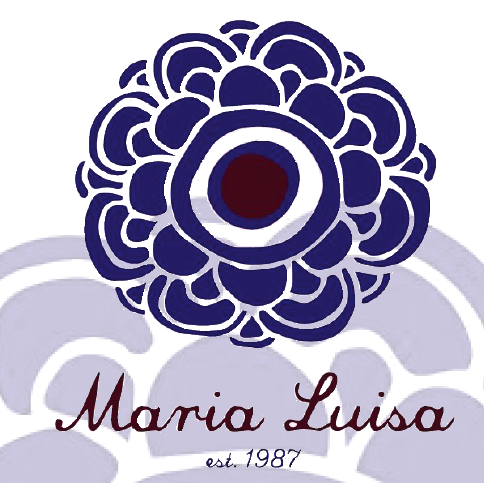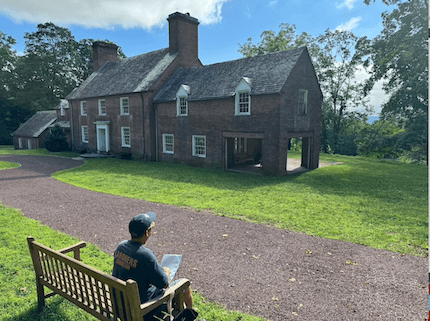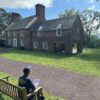 Earth Matters focuses on conservation, sustainability, recycling and healthy living. This weekly series is brought to you by Maria Luisa Boutique.
Earth Matters focuses on conservation, sustainability, recycling and healthy living. This weekly series is brought to you by Maria Luisa Boutique.
If Earth Matters to you, sign up for our mailing list and get the next installment delivered bright to your inbox.
by Jennifer Giunta
The pedigree of honey
Does not concern the bee.
A clover, anytime, to him
Is aristocracy – Emily Dickinson
Contrary to my favorite quote from Emily Dickinson, bees can be a bit picky about their flowers.
Thanks to the wonderful educational programs provided by Cornell Cooperative Extension of Rockland County, The Native Plant Center and the writings of Doug Tallamy, gardeners are more aware of the virtues of native plants. Experts consider native plants to be those that are indigenous to a certain area, ecosystem, or habitat, and were here before the European settlers.
Good citizens are more than willing to adapt the way they plant, help our native birds, bees, and butterflies, and assist in preserving the ecological balance. Climate change, invasive species, and habitat devastation due to development are having a profound effect on our native plant communities, and planting natives in our home gardens is a way to combat that stress. Reports of pollinator decline are also inspiring gardeners to plant with them in mind.
Most of us planting at home, however, are also looking for plants to add the beauty of our landscapes. Garden centers offer a wide variety of blooming temptations, with increasing numbers of them labeled “native.” However, many of these natives are actually cultivated selections of native plants known as nativars. Nativars are often showier, sexier, more compact, better smelling, or longer blooming versions of their straight species ancestors, and many are natural variants that have been found in the wild and propagated by plant breeders. Do your research, however, before you buy them if your objective is to help your local wildlife. A straight species, or plant that occurs naturally in a given area, is almost always their preferred host. Nativars are often recognizable by their label, which usually contains a single quotation mark on either side of a catchy name after the name of the species. For example: Echinacea purpurea ‘Razzmatazz.’

Cultivars that feature fuller flowers with more petals can make it more difficult for pollinators to access pollen and nectar.
Planting nativars can affect plant diversity because most represent only a small selection of unusual traits. They are often propagated through hybridization, which is an intentional cross between two species in order to encourage desired traits, or by cloning, which produces genetically identical plants. These plants will have less ability to adapt to stresses such as disease or drought than those that start their lives as seeds, because of the lack of genetic diversity.
More research is needed, but in the meantime, a few guidelines. If planting for native habitat it’s best to avoid:
- Plants with day-glo, unnaturally intense coloring. Insects don’t see color like we do and may not recognize it.
- Double flowers that obscure a flower’s interior or cone. These traits can make it impossible for insects to enter the flower. Or they might even eliminate pollen and nectar altogether.
- Any plant that is touted for its reluctance to set seed. Seed production is critical to biodiversity.
- Nativars with purple leaves. These have been found to not be as attractive to caterpillars due to chemicals known as “anthocyanins,” which deter insect feeding.
- Plants with variegated leaves. These types of leaves contain less chlorophyll, which makes the leaves less nutritious, and less recognizable.
This is not to suggest that you rip out already-planted nativars! Nativars are still more beneficial to the ecosystem than most exotics, and they are usually more available at retail sites. If you have them planted in your garden, consider doing your own research. Try planting a straight species of the same type alongside it, and observe how the wildlife interacts with it in contrast to that of the nativar. Are the bees favoring one over the other? Is one producing a larger cone or more seeds?
Check out the resources below to learn more. And finally, consider growing your own native plants from locally collected seed. If local seed is hard to find, Wild Seed Project in Maine and Prairie Moon Nursery in Minnesota have many types for sale.
- The dissertation of Annie White at the University of Vermont, examined pollinator visits to 12 native species and 14 cultivars.
- Mt.Cuba Center, a native plant garden in Delaware, has trialed natives and nativars together. .
- Budburst’s Nativar Research Project at the Chicago Botanic Garden, launched in 2018, brings gardeners from different sectors together to collect data. Consider joining and adding your observations.
- A research article by Emily Baisden, Doug Tallamy, and associates examines cultivars’ support of insect herbivores.
Jennifer Giunta is co-owner of Cottage Creek Gardens, a home-based plant nursery in Valley Cottage, NY and a co-founder of The Nyack Seed Exchange at The Nyack Library.
Read Earth Matters every Wednesday on Nyack News And Views, or sign up for the Earth Matters mailing list.
 Earth Matters focuses on conservation, sustainability, recycling and healthy living. This weekly series is brought to you by Maria Luisa Boutique.
Earth Matters focuses on conservation, sustainability, recycling and healthy living. This weekly series is brought to you by Maria Luisa Boutique.








